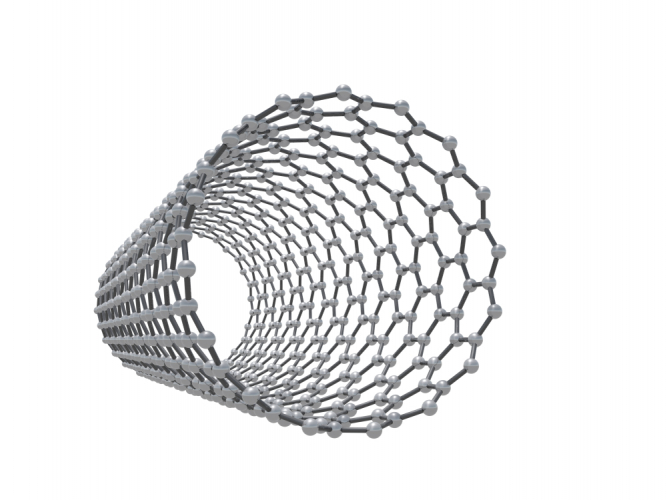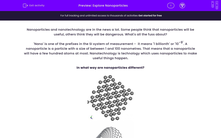Nanoparticles and nanotechnology are in the news a lot. Some people think that nanoparticles will be useful, others think they will be dangerous. What's all the fuss about?
'Nano' is one of the prefixes in the SI system of measurement - it means '1 billionth' or '10-9'. A nanoparticle is a particle with a size of between 1 and 100 nanometres. That means that a nanoparticle will have a few hundred atoms at most. Nanotechnology is technology which uses nanoparticles to make useful things happen.
In what way are nanoparticles different?
(1).png)

The top picture here shows 'normal' carbon atoms arranged in a giant covalent structure to make diamond. The bottom picture shows a carbon nanotube, which was one of the first nanoparticles discovered. Notice that all the atoms in the nanotube are at the surface of the shape. They are all available for a chemical reaction. In the diamond structure, most of the atoms are tucked away inside the structure, where they cannot react. The pattern of bonding is also different at the surface compared with inside the particle.
We can do the same sort of thing with other substances. By cutting them into smaller and smaller pieces, an increasing fraction of the atoms will be at the surface of the material. This means that we can make nanoparticles of virtually any substance.
How are nanoparticles useful?
Because nanoparticles have lots of atoms at the surface of the particle, nanoparticles have different properties to the same chemicals found in different particles. Here are some examples:
Many nanoparticles are very reactive, so they act as excellent catalysts. In a catalyst, the surface is the relevant part of the material, so it is helpful to have a material which is nothing but surface.
Some nanoparticles work well as antibacterials. Silver nanoparticles stop bacteria growing, which is useful in surgical dressings, such as bandages. Adding silver nanoparticles to clothes prevents bacteria growing on sweat, so the nanoparticles act as a deodorant.
Some nanoparticles - for example carbon nanotubes - are able to conduct electricity.
Nanoparticles of titanium dioxide are added to sunscreen. Larger particles of TiO2 are also able to do this, but they leave more marks on skin.
Another clever aspect of using nanoparticles is that their small size means that we don't need much raw material to make lots of nanoparticles. This means that it doesn't matter if the raw materials are expensive, like gold or platinum - we won't need much!
Are nanoparticles safe for us to use?
We can't be sure whether the use of nanoparticles is safe. We know what their properties are like, but we have only used nanoparticles for a few years. We won't know for sure what their long-term effects on people are for a long time. The main risk seems to be if people inhale nanoparticles - if nanoparticles get trapped in the lungs, they could be harmful. But at the moment, we're not sure. However, many of the uses of nanoparticles don't allow them to be breathed in, which should make their use safer.
There's a lot we still don't know about nanoparticles. We know the general things they can do, but not all the possibilities. We also need to be more sure about their long-term safety. There's lots for future scientists to still find out!
Now it's time to have a go at some questions.








